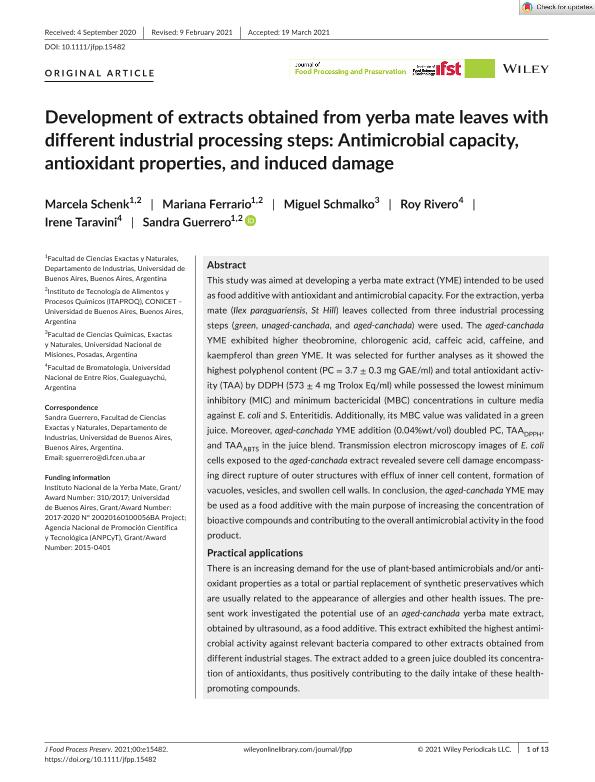Artículo
Development of extracts obtained from yerba mate leaves with different industrial processing steps: Antimicrobial capacity, antioxidant properties, and induced damage
Schenk, Marcela Liliana ; Ferrario, Mariana Inés
; Ferrario, Mariana Inés ; Schmalko Radichowski, Miguel Eduardo; Rivero, Roy Cristian
; Schmalko Radichowski, Miguel Eduardo; Rivero, Roy Cristian ; Taravini, Irene Rita Eloisa
; Taravini, Irene Rita Eloisa ; Guerrero, Sandra N.
; Guerrero, Sandra N.
 ; Ferrario, Mariana Inés
; Ferrario, Mariana Inés ; Schmalko Radichowski, Miguel Eduardo; Rivero, Roy Cristian
; Schmalko Radichowski, Miguel Eduardo; Rivero, Roy Cristian ; Taravini, Irene Rita Eloisa
; Taravini, Irene Rita Eloisa ; Guerrero, Sandra N.
; Guerrero, Sandra N.
Fecha de publicación:
28/03/2021
Editorial:
Wiley Blackwell Publishing, Inc
Revista:
Journal of Food Processing and Preservation
ISSN:
0145-8892
e-ISSN:
1745-4549
Idioma:
Inglés
Tipo de recurso:
Artículo publicado
Clasificación temática:
Resumen
This study was aimed at developing a yerba mate extract (YME) intended to be used as food additive with antioxidant and antimicrobial capacity. For the extraction, yerba mate (Ilex paraguariensis, St Hill) leaves collected from three industrial processing steps (green, unaged-canchada, and aged-canchada) were used. The aged-canchada YME exhibited higher theobromine, chlorogenic acid, caffeic acid, caffeine, and kaempferol than green YME. It was selected for further analyses as it showed the highest polyphenol content (PC = 3.7 ± 0.3 mg GAE/ml) and total antioxidant activity (TAA) by DDPH (573 ± 4 mg Trolox Eq/ml) while possessed the lowest minimum inhibitory (MIC) and minimum bactericidal (MBC) concentrations in culture media against E. coli and S. Enteritidis. Additionally, its MBC value was validated in a green juice. Moreover, aged-canchada YME addition (0.04%wt/vol) doubled PC, TAADPPH, and TAAABTS in the juice blend. Transmission electron microscopy images of E. coli cells exposed to the aged-canchada extract revealed severe cell damage encompassing direct rupture of outer structures with efflux of inner cell content, formation of vacuoles, vesicles, and swollen cell walls. In conclusion, the aged-canchada YME may be used as a food additive with the main purpose of increasing the concentration of bioactive compounds and contributing to the overall antimicrobial activity in the food product. Practical applications: There is an increasing demand for the use of plant-based antimicrobials and/or antioxidant properties as a total or partial replacement of synthetic preservatives which are usually related to the appearance of allergies and other health issues. The present work investigated the potential use of an aged-canchada yerba mate extract, obtained by ultrasound, as a food additive. This extract exhibited the highest antimicrobial activity against relevant bacteria compared to other extracts obtained from different industrial stages. The extract added to a green juice doubled its concentration of antioxidants, thus positively contributing to the daily intake of these health-promoting compounds.
Palabras clave:
YERBA MATE
,
ANTIOXIDANTS
,
ANTIMICROBIAL ACTIVITY
,
POLYPHENOLS
Archivos asociados
Licencia
Identificadores
Colecciones
Articulos(ITAPROQ)
Articulos de INSTITUTO DE TECNOLOGIA DE ALIMENTOS Y PROCESOS QUIMICOS
Articulos de INSTITUTO DE TECNOLOGIA DE ALIMENTOS Y PROCESOS QUIMICOS
Articulos(SEDE CENTRAL)
Articulos de SEDE CENTRAL
Articulos de SEDE CENTRAL
Citación
Schenk, Marcela Liliana; Ferrario, Mariana Inés; Schmalko Radichowski, Miguel Eduardo; Rivero, Roy Cristian; Taravini, Irene Rita Eloisa; et al.; Development of extracts obtained from yerba mate leaves with different industrial processing steps: Antimicrobial capacity, antioxidant properties, and induced damage; Wiley Blackwell Publishing, Inc; Journal of Food Processing and Preservation; 45; 6; 28-3-2021; 1-13
Compartir
Altmétricas



